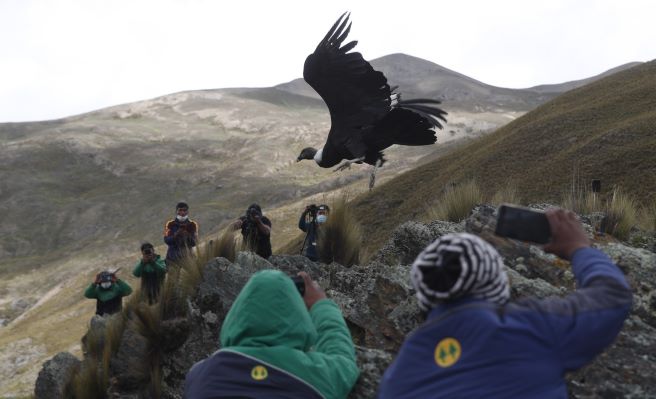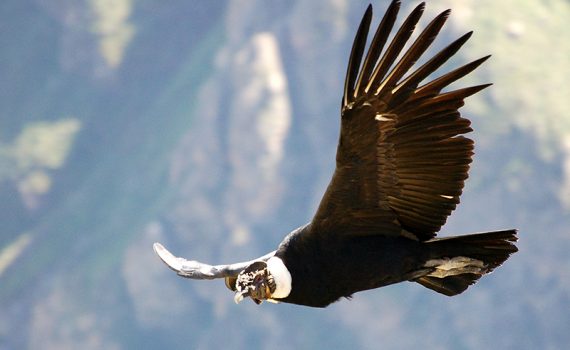The Andean condor (Vultur gryphus) plays an important ecological role as a scavenger because it accelerates the decomposition process of dead animals, thus reducing the risk of diseases associated with slow rotting of animals. It also has evolutionary importance because it is one of the seven species of American vulture known for its great sense of smell, an unusual characteristic in birds. It can live for more than 50 years in freedom and up to 80 in captivity.
It measures around 142 cm in height and reaches a 330 cm wingspan. Its range of distribution narrows through the Andes from the north in Colombia to the extreme south of Chilean and Argentine Patagonia, passing through Peru, Ecuador and Bolivia.
Since ancient times it has been an important animal in the mythology and traditions of the Andean world, for example for the Incas, who considered it immortal and the representation of the Jananpacha, the land above, the sky and the future.
What is the Cóndor Animal?

condor andino peru 
condor andino peru
The Andean condor is a huge bird that is among the largest in the world capable of flight. Given its heavy weight (up to 15 kilograms), even its massive wingspan (3 meters) needs some help to keep it aloft. For this reason, these birds prefer to live in windy areas, where they can glide on air currents without great effort. Andean Cóndor Animals live in mountainous areas, as their name suggests, but also near the coasts, where sea breezes abound, and even in deserts with strong thermal air currents.
10 facts about the Cóndor Animal:
- His name in Quechua is kuntur and the Incas believed that he was immortal. It represented the Jananpacha, the land above, the sky and the future.
- The distance between the tips of its outstretched wings (about 3.3 meters) represents the largest wingspan of a land bird.
- They are monogamous and both parents incubate the egg. Their young stay with their parents for up to 2 years before facing the world alone.
- At certain times of the year (in October in Peru), they fly from the peaks of the Andes to the Pacific coast to eat the carrion of dead sea lions.
- It is one of the only predators that can break the tough skin of guanacos with its beak.
- They mature sexually late (minimum at 5 years, with some reports of the first calf at 11 years), and only have one calf every 2-3 years. This makes them very vulnerable to threats.
- It is part of the Cathartidae family, which comes from the Greek kathartes which means “the one who cleanses”.
- Fly thanks to the thermal boost, which helps you see the carrion from very high and reach it without wasting energy.
- Males have a white collar and crest that differentiates them from females.
- It is found in four national shields, where it represents different values: Bolivia (search for a horizon without limits), Chile (strength), Colombia (freedom and order), and Ecuador (power, greatness and value).
Characteristics of the Cóndor Animal:
These condors are usually black, but have a characteristic white “collar”, as well as some markings of the same color on their wings. Like their relatives, the Californian condors, the Andeans sport bald heads.
Condors are vultures; that is why their accurate eyes are always on the lookout for carrion, which makes up most of their diet. They prefer to feed on large animals, whether wild or domesticated, and by consuming their bodies they do an important job as sweepers of nature. On the coast, condors feed on dead marine animals, such as seals or fish. These birds lack the sharp claws of predators, but they can raid nests in search of eggs or even chicks.
Among the most interesting qualities that condors have is the fact that they are one of the most faithful species in nature. This is because once they choose a partner they are able to stay with him for the rest of his life. Another important aspect is that they fulfill a valuable ecological function. And it is that being a scavenger bird, the condor accelerates the decomposition process of lifeless species and thus prevents the proliferation of disease-causing microbes.
Possessing an elongated and pointed beak, the condor can tear food easily, while its eyes located at both ends of its head give it a wide visual field that allows it to identify dead animals from a great distance.
This bird is also one of the longest-lived species in the world, as it is capable of living up to 80 years. Its reproductive cycle reaches sexual maturity at eight years old and lays eggs every two, which makes it an endangered animal due to its low rate of offspring. For this reason, its care and state of conservation are a priority not only in Peru, but in all the countries of the region, where important measures are being taken in order to ensure the protection and quality of life of this majestic bird.
Size of Condor Bird
The scientific name of the Andean Condor is vultur gryphus, there are some approximate data regarding size of Condor bird: height 1.3 meters, wingspan 3.5 meters, they live for about 50 years although there are specimens that reach 75 years They weigh from 11 kg to 13Kg and the males are larger than the females.
Royal Condor
The Royal Condor is found from Mexico to the north of Argentina. Its distribution includes Mexico, Central America, Colombia (rare in Chocó), Peru, Bolivia, Brazil and Argentina.
Among the American vultures the Royal Condor is medium in size. The Royal Condor bird size is not as big as the Andean Condor or the California Condor. In length it measures from 70 to 85 cm. The weight reaches 3.5 kilograms, which is considerable for a flying bird. The genera are similar in appearance.
California condor
The California Condor, gymnogyps californianus, whose range spans the Pacific coast from Canada; extending through Mexico and the South of the United States, the California Condor bird size is approx. 1.15 meters to 1.40 meters in height and weighs more or less 10 kg, with outstretched wings it measures 3 meters in wingspan.
Hábitat
Its range of distribution narrows through the Andes from the north in Colombia to the extreme south of Chilean and Argentine Patagonia, passing through Peru, Ecuador and Bolivia.
The Cóndor‘s habitat encompasses the entire Andean region, in Perú populations can be seen in Arequipa, Cusco, Apurímac, Lima, Junín, Huancavelica, among other regions. There are joint public and private efforts for the conservation of this species.
In Perú, the Cóndor lives in high altitude areas such as the Colca Valley (1,131 kilometers southeast of Lima), in Arequipa; although it has also been seen in some places along the coast.
A deity for the Inca culture
Historically considered a sacred bird in Peru, the Andean condor has witnessed the origin and splendor of various cultures and civilizations by acquiring a symbolic role in many of them, it has even been represented in ceramics, paintings and looms. The Incas were one of his greatest admirers: they came to consider him a divinity in charge of uniting heaven and earth.
This mystical relationship is demonstrated in one of the main temples of the sanctuary of Machu Picchu where the figure of the condor lies in detail engraved on a large stone. Historians say that this effigy may have been used as a sacrificial altar, since there is a belief that condors were capable of raising the spirit of the dead to heaven.
According to the Andean worldview, this ancient species belongs to a sacred trinity along with the puma and the serpent, which represented heaven, earth and the world of the dead, respectively. Currently, many peoples of Peru celebrate traditional rituals known as the Yawar Fiesta or blood festival, where the condor acts as the main protagonist.
Threat of Extinction
The Andean condor is a threatened species, but its situation is much better than that of its California cousin. There are currently about several thousand South American condors in the wild, and reintroduction programs are working to increase their numbers.
The Andean condor faces various threats: as it is a bird with a low population by nature, with very wide ranges of action and low reproductive rates, the viability of its populations is a real concern. Their sporadic attacks on domestic livestock have contributed to a poor image and consequently there have been cases of illegal carrion poisoning and lead contamination due to hunting. This, added to its unregulated use for handicrafts and bullfights during the Yawar Fiesta, in addition to the effects that are seen by climate change, aggravate their situation.










